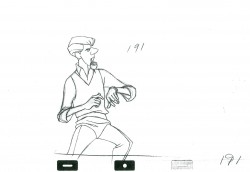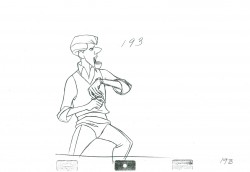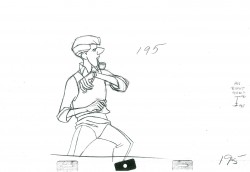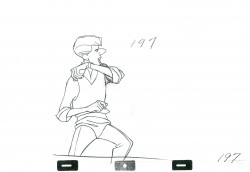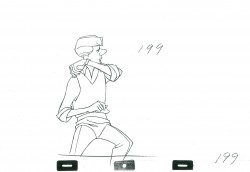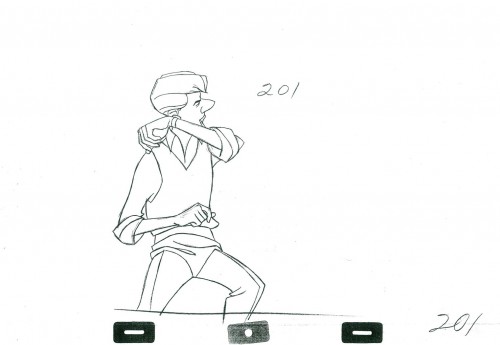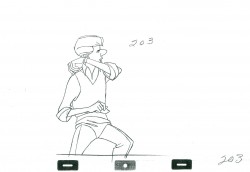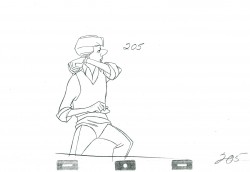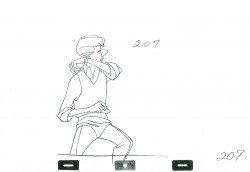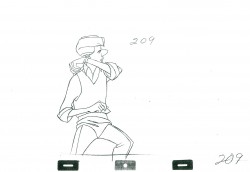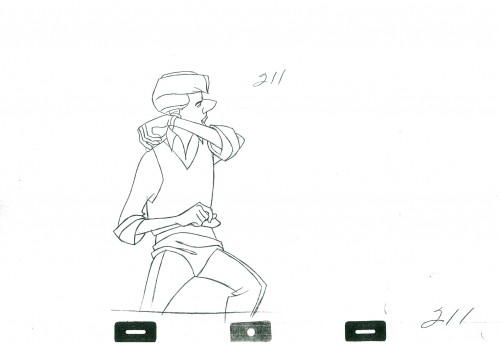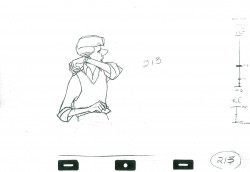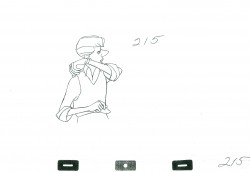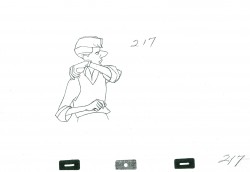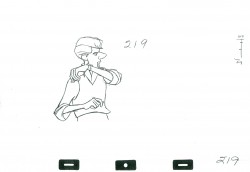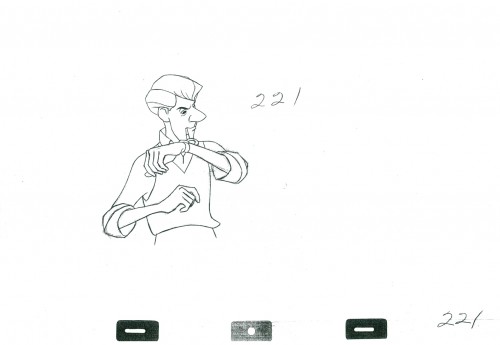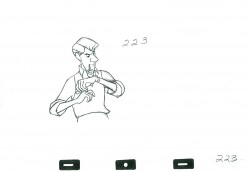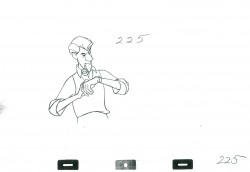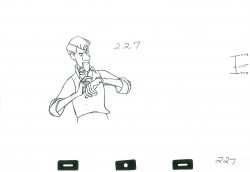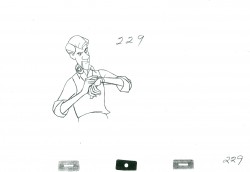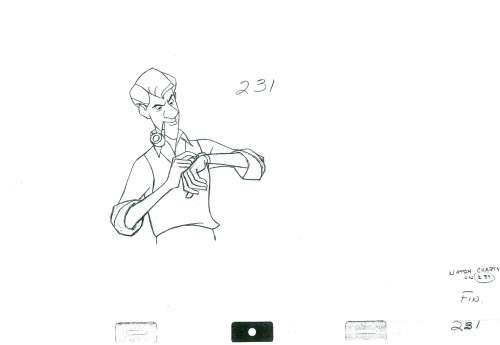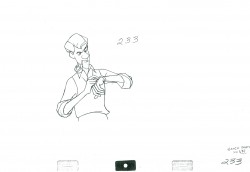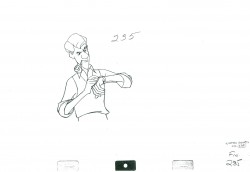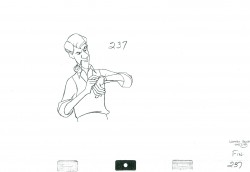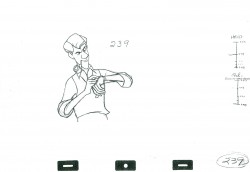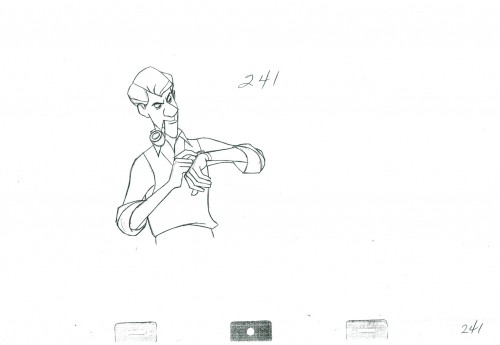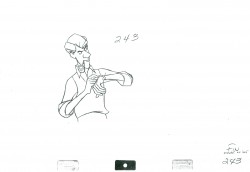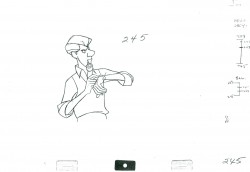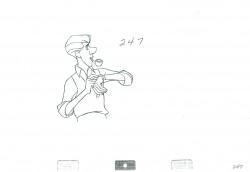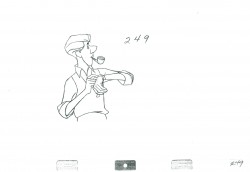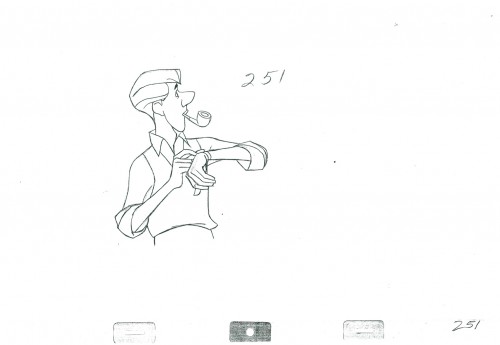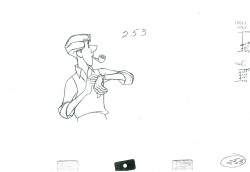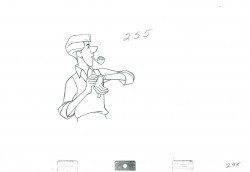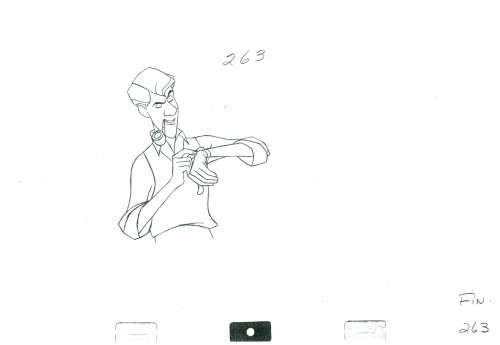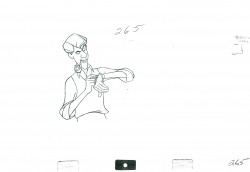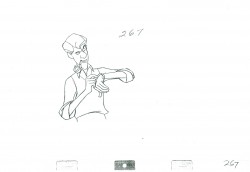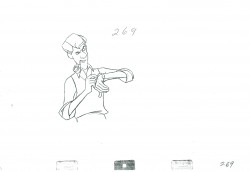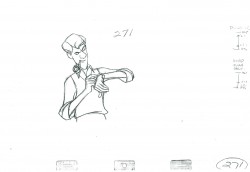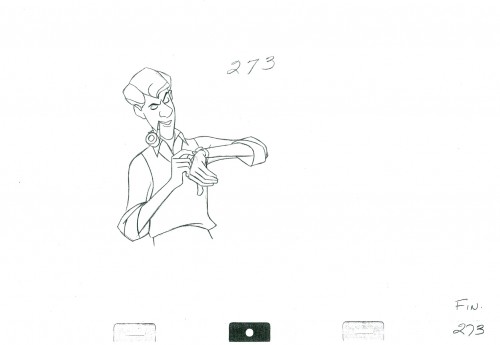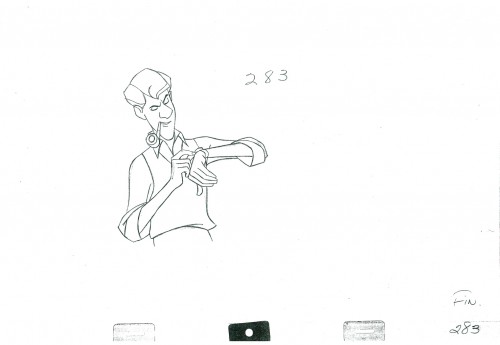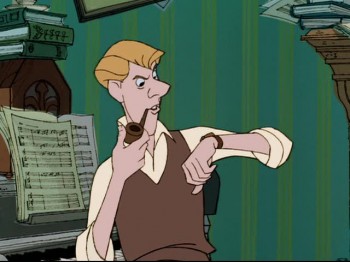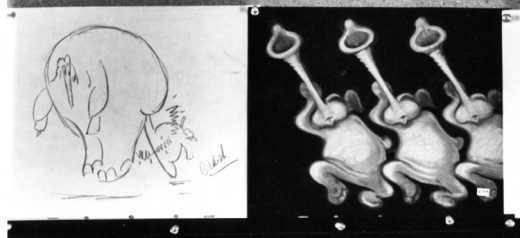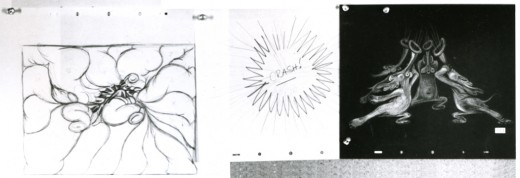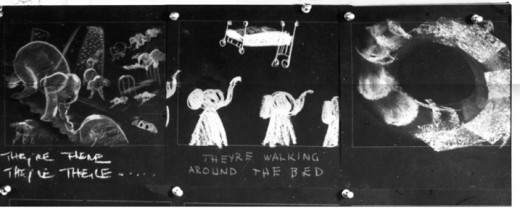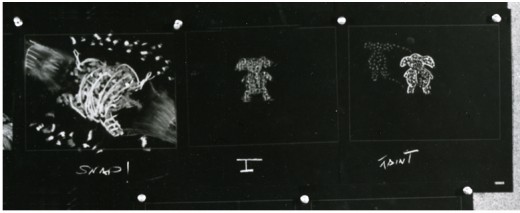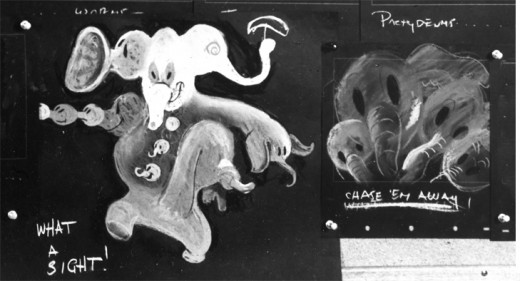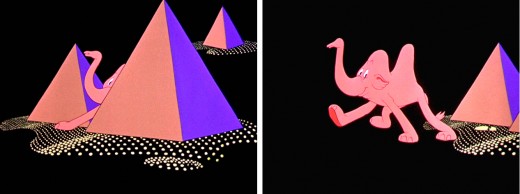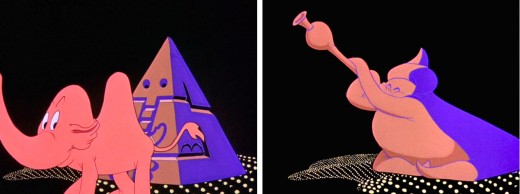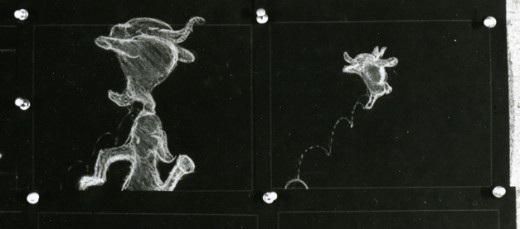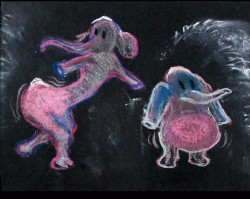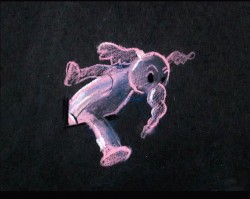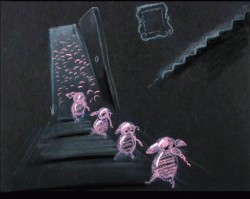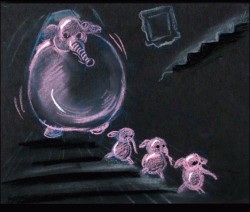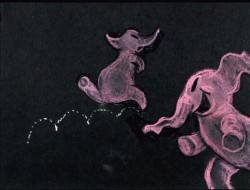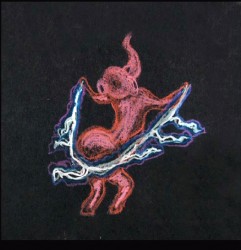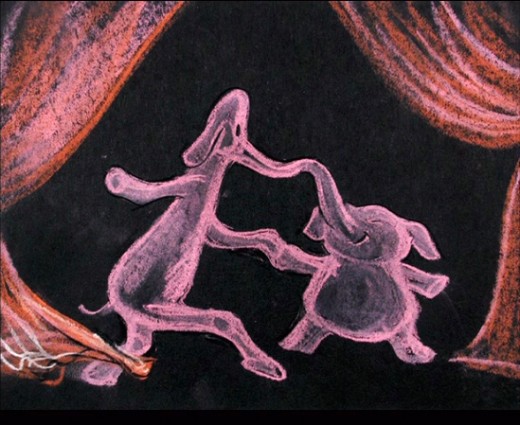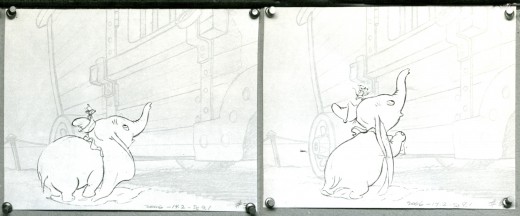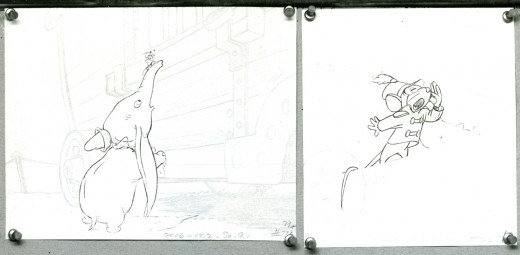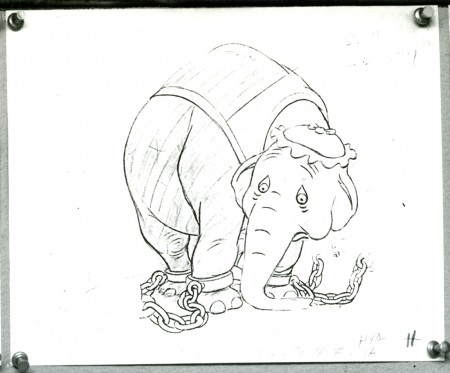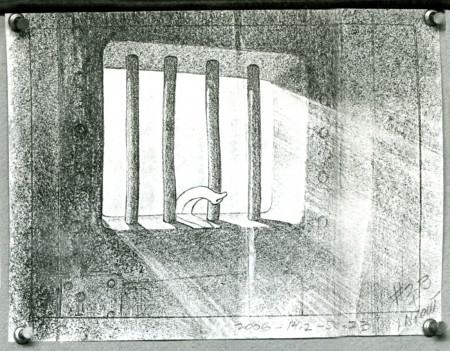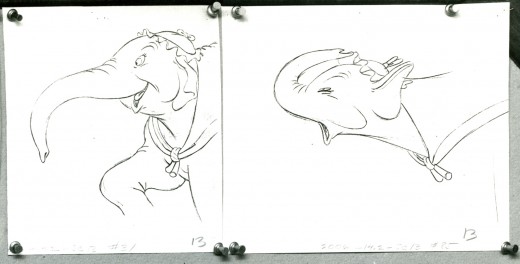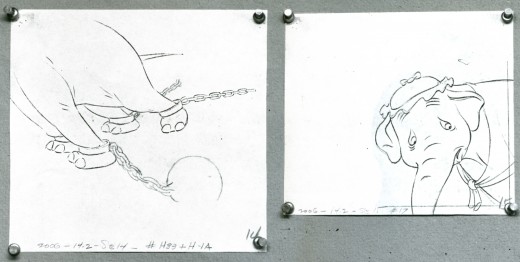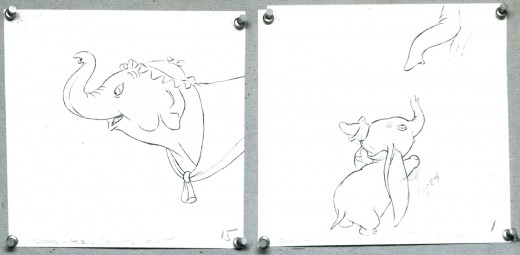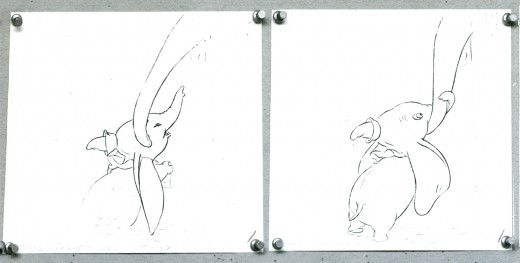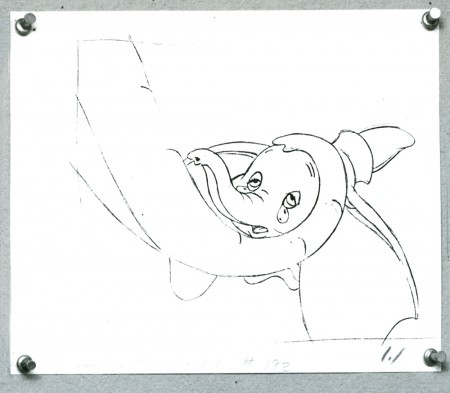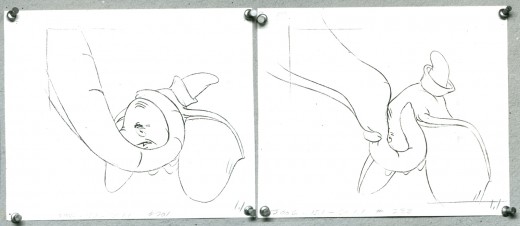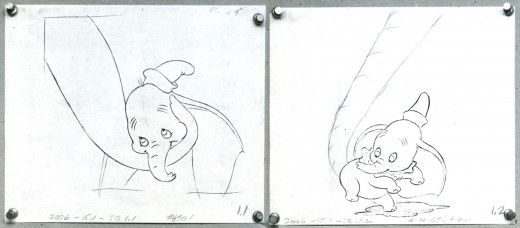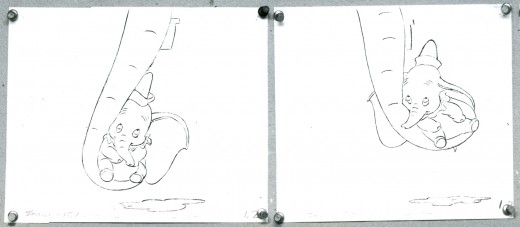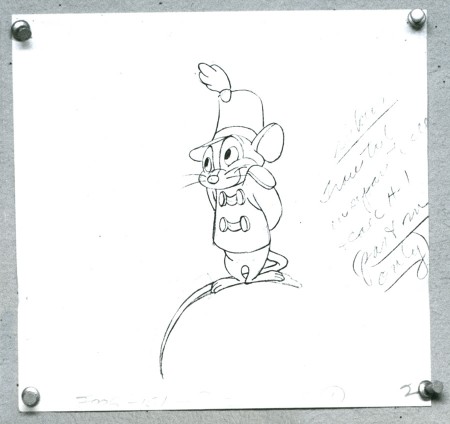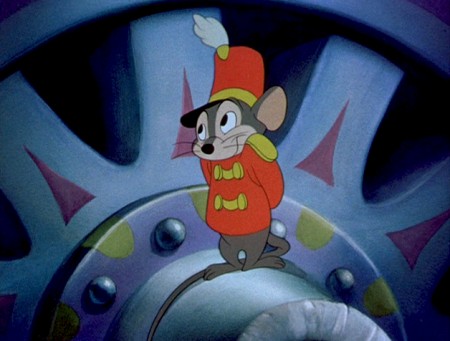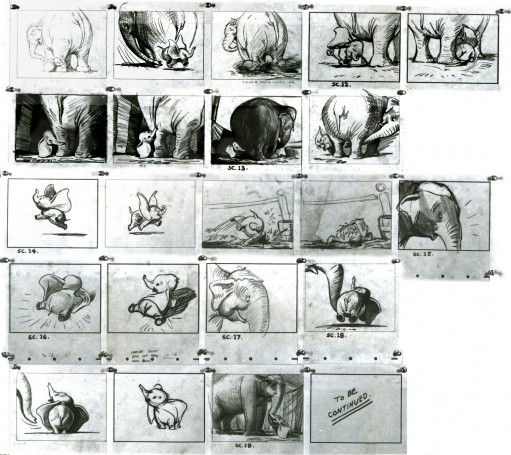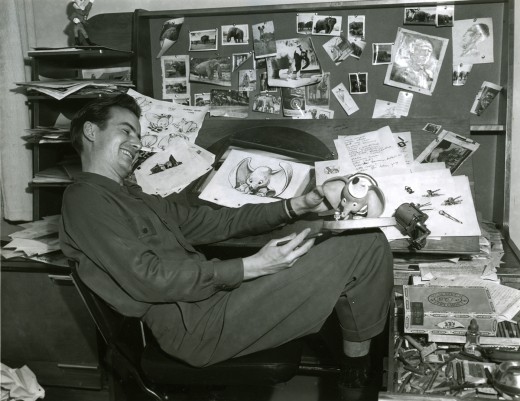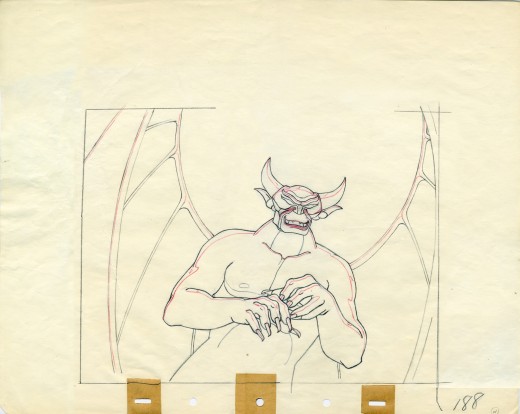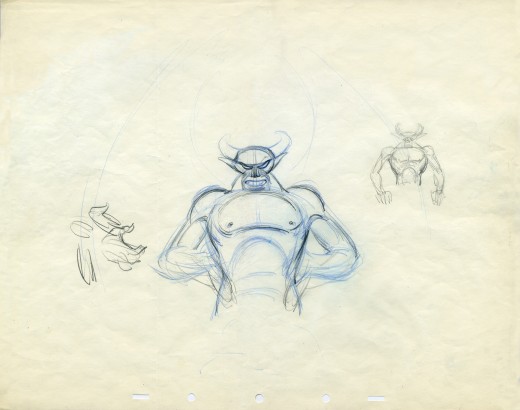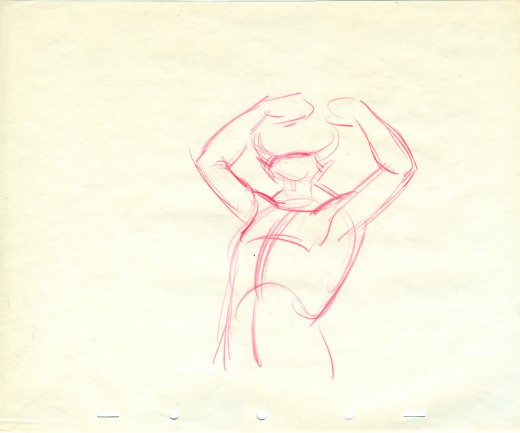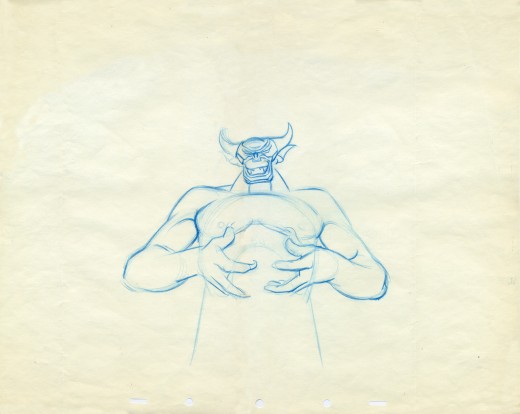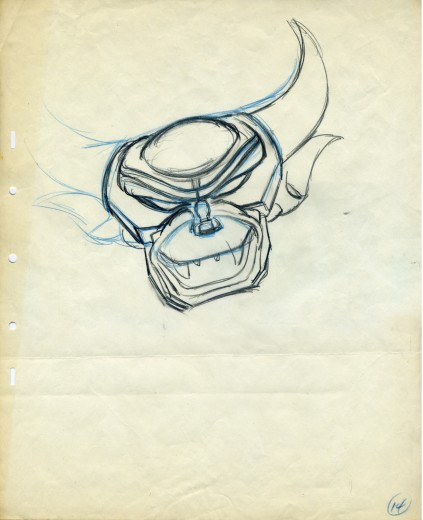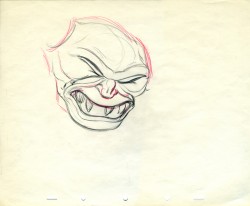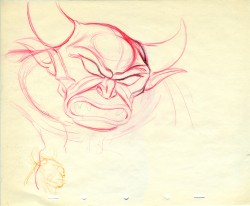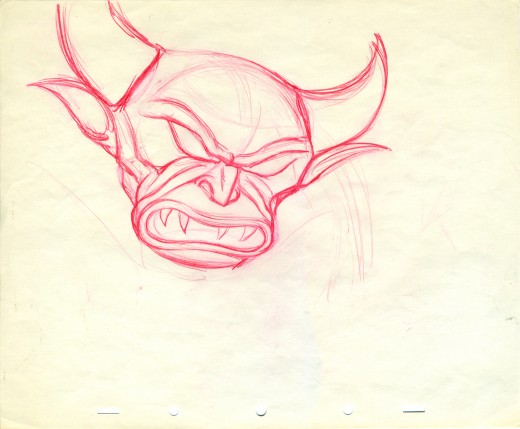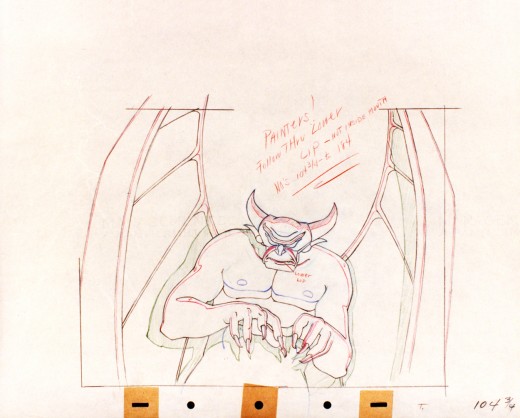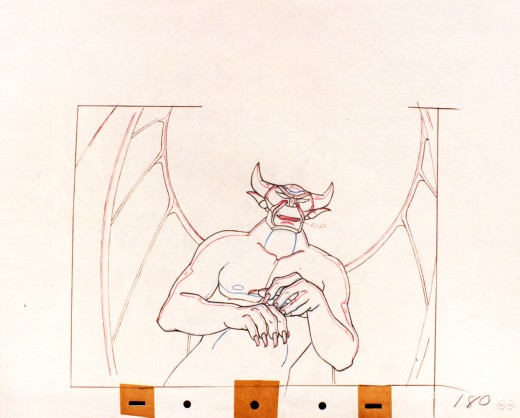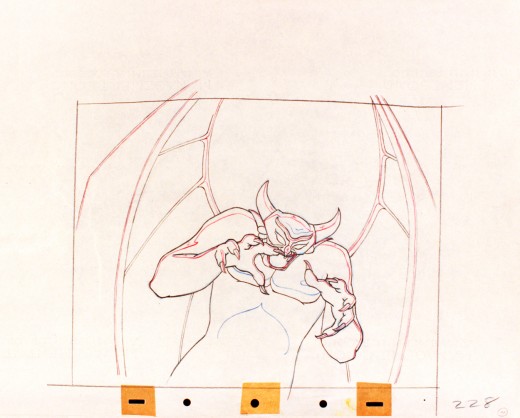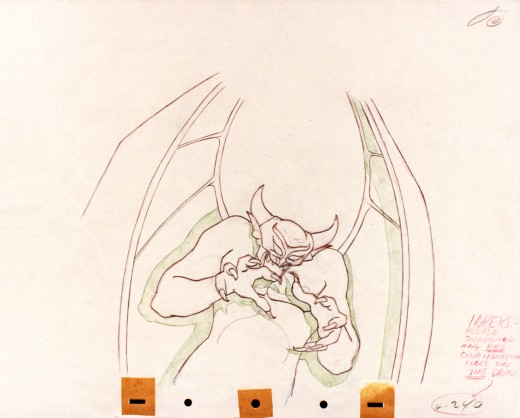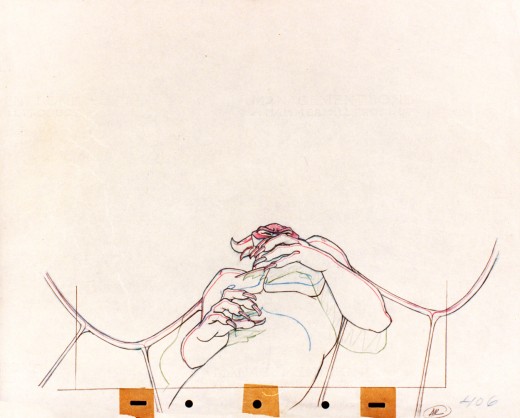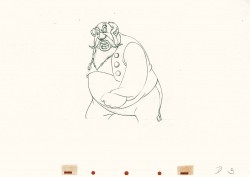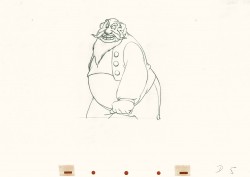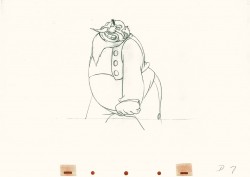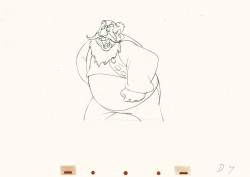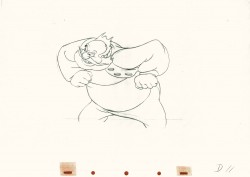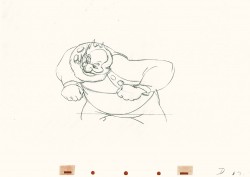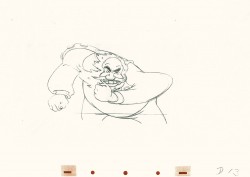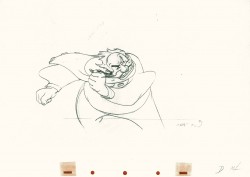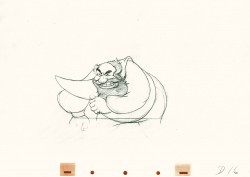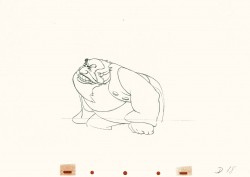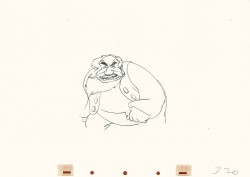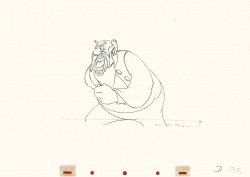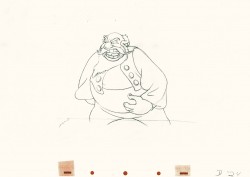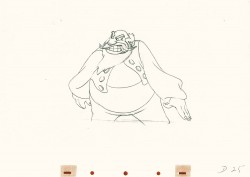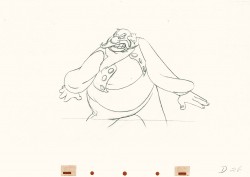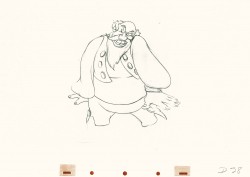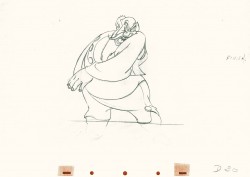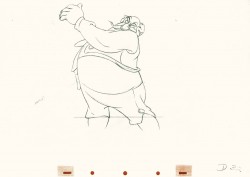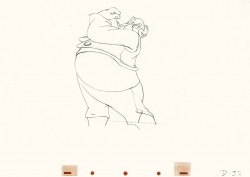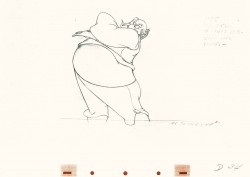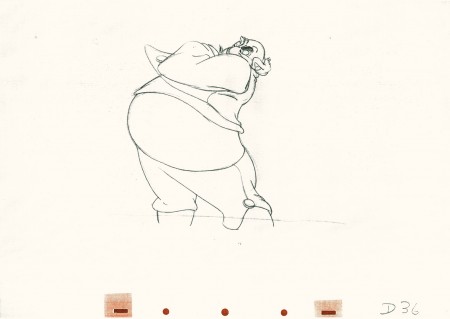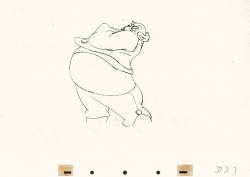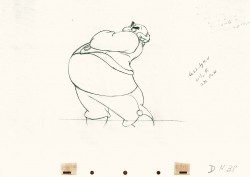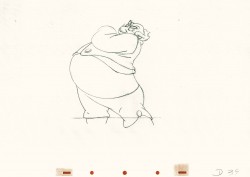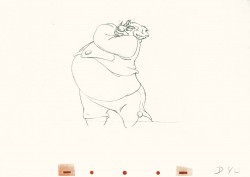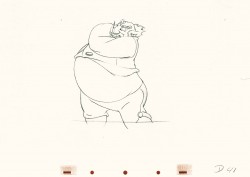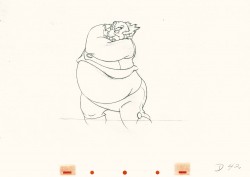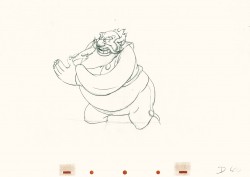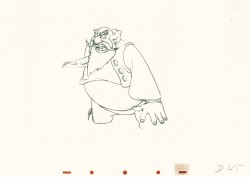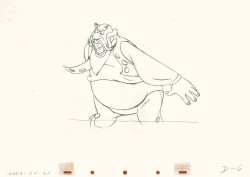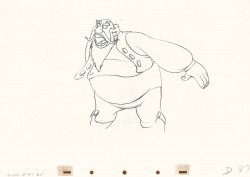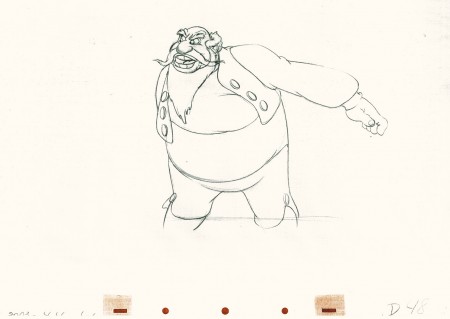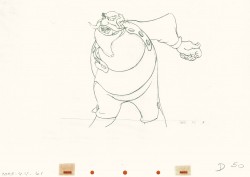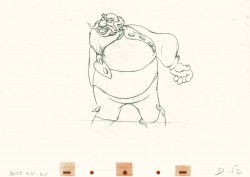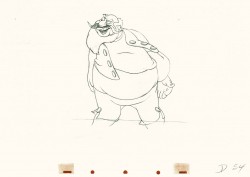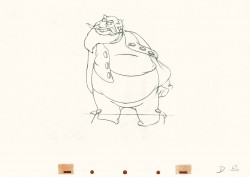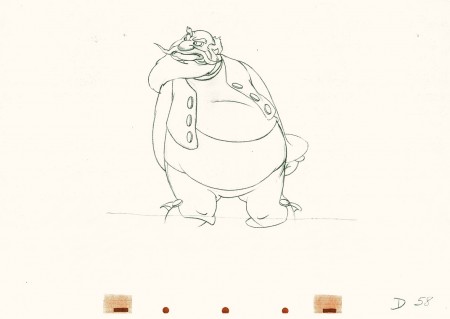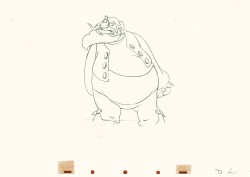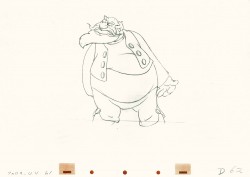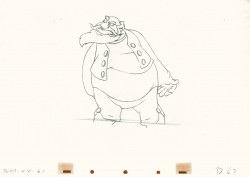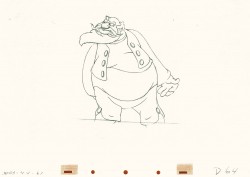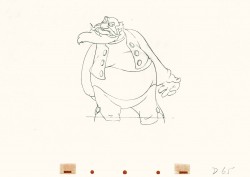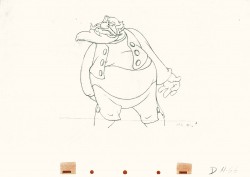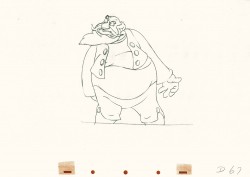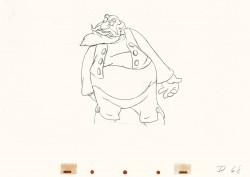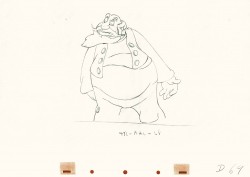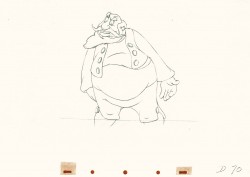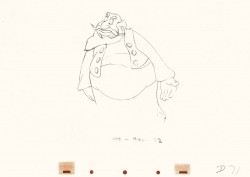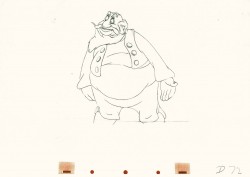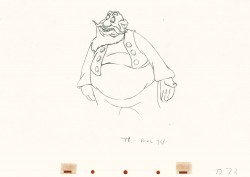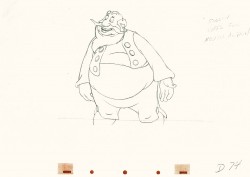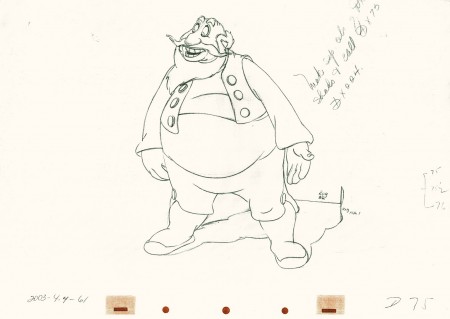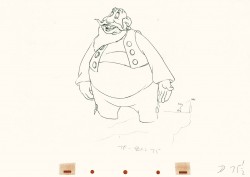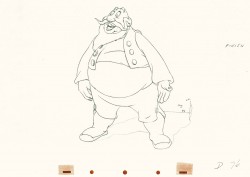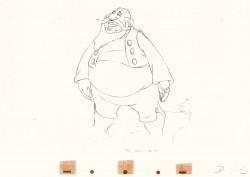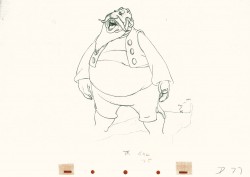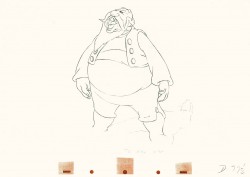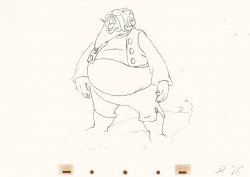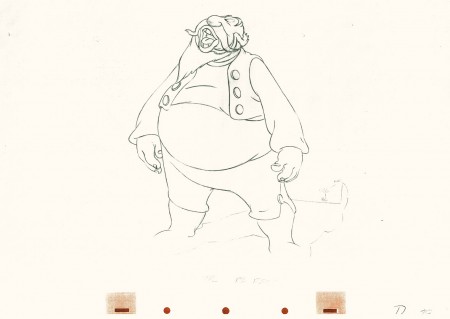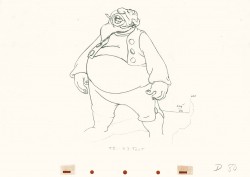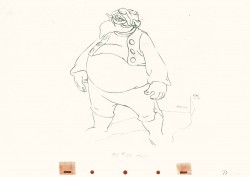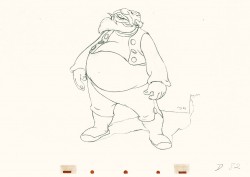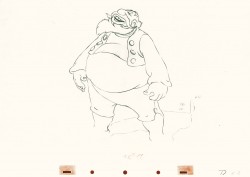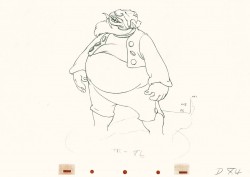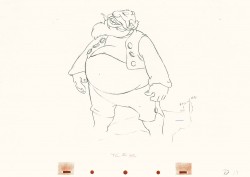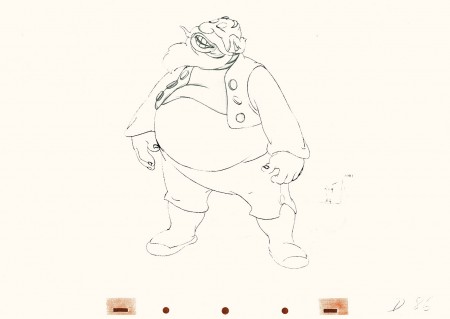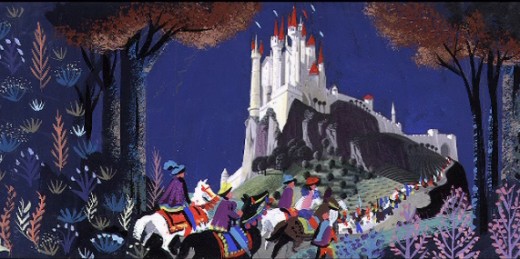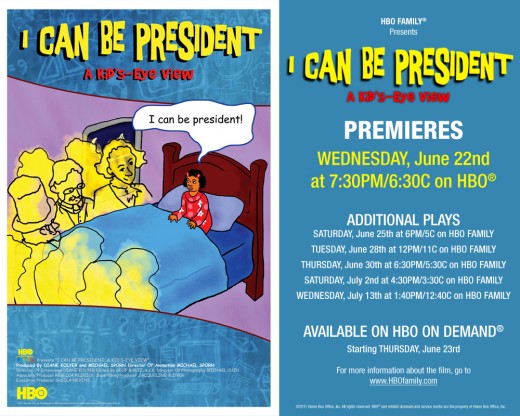Search ResultsFor "dumbo"
Commentary 08 Apr 2012 07:02 am
Moving On
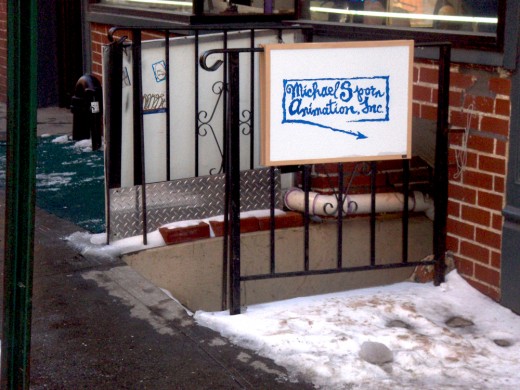 - It’s a week later, and the move out of the Bedford Street studio is done. Most of the furniture, artwork and computers have been put in storage. It was a big decision to have made and done quickly and expeditiously. It was also a touch traumatic. Giving up the space wasn’t easy. I’d been thinking of doing it for the past year, and the inevitable had to happen. I realized that only a couple of weeks ago.
- It’s a week later, and the move out of the Bedford Street studio is done. Most of the furniture, artwork and computers have been put in storage. It was a big decision to have made and done quickly and expeditiously. It was also a touch traumatic. Giving up the space wasn’t easy. I’d been thinking of doing it for the past year, and the inevitable had to happen. I realized that only a couple of weeks ago.
So now I’m working out of my home and will also be occupying a desk alongside Candy Kugel at her company Buzzco; she’s given me access to her facilities. That will get me out of my house and make my days a bit more interesting. Lest there be any doubt, Michael Sporn Animation, Inc. still exists, and in fact we’re currently working on a spot for AARP with Bob Blechman. That’ll be done in the next week. Matt Clinton is doing his part out of Michigan, while I work in the City.
A couple of big thank you’s for the move have to go out to two great friends. The move could not have happened without the back breaking work of Stephen MacQuignon. What a guy he is; I just can’t say enough about him. Bridget Thorne was also essential in getting it going and boxing up so many damn books. She was the vision behind the move. Of course, Heidi Stallings, my wife, was there all the way with me making sure I didn’t push too hard. Thank you to all three of them.
- I’m haven’t surrendered to Kickstarter after not reaching the enormously high goal I’d set for myself. I’m hoping to start anew in the next week or so, but this time I’ll be using Indiegogo. It seems much more reasonable in the way they’re set up. Of course, I’ll reach out and let you know when I’ve got it going. I want to get started on POE‘s opening and have been working by myself, for now, on that. Any moneys I can generate through such a device would be glorious.
- Gene Deitch on his site, gene deitch credits, has an absolutely great piece about Morton Schindel. Schindel was the smart entrepreneur who set up Weston Woods in the 1950s, and he deserves more attention in the business. His company has thrived for more than fifty years doing quiet films based on well-known children’s books. Deitch got a firm foothold of a customer with Weston Woods, and I got my real start as a studio with a couple of films from the Schindel, and the guy who actually runs the production now, Paul Gagne.
I knew that the early WW films were shown on Captain Kangaroo, but I wasn’t aware that Gene Deitch was responsible for that happening. It’s a good little piece of history worth reading.
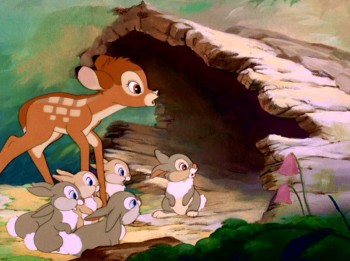 -With the recent introduction of their new cable channel, Disney Junior, Disney has been screening a number of the early animated features on the channel. I happened to catch Bambi yesterday. Of course, it’d have been easy for me to just put in the DVD, but somehow accidentally coming upon the film makes it hard to pass up. Considering how immersed I’ve been in the UPA films and the Miyazaki canon, it always brings you back to ground zero when you see one of these early Disney masterpieces. They can’t be beat. Bambi, in particular challenges any notions of modern art with Tyrus Wong‘s stunning Backgrounds and design. The Bgs turn almost abstract at times. When the deer on the meadow are running away, for fear of man, the animals turn wildly brilliant colors. It caught my eye the first time I saw the film, as a child, and I still look for it.
-With the recent introduction of their new cable channel, Disney Junior, Disney has been screening a number of the early animated features on the channel. I happened to catch Bambi yesterday. Of course, it’d have been easy for me to just put in the DVD, but somehow accidentally coming upon the film makes it hard to pass up. Considering how immersed I’ve been in the UPA films and the Miyazaki canon, it always brings you back to ground zero when you see one of these early Disney masterpieces. They can’t be beat. Bambi, in particular challenges any notions of modern art with Tyrus Wong‘s stunning Backgrounds and design. The Bgs turn almost abstract at times. When the deer on the meadow are running away, for fear of man, the animals turn wildly brilliant colors. It caught my eye the first time I saw the film, as a child, and I still look for it.
The beauty of some of the animation cannot be challenged, and the airbrushed coloring is stunning. Looking at some of the simple and direct multiplane setups one can only sit in awe. There’s a bit of randomness that has to take over with the multiplane camera, and that brings a touch of life to these camera moves. A good example is the very last scene of the “April Showers” sequence with the camera making a very slight move down and a pull out to reveal Bambi and his mother in the larger forest. The out of focus elements shift to in-focus, and it’s beatuiful. Even watching this film with the advanced use of the computer to composite such films today, the production work can’t be beaten or matched.
We’ll never see the likes of the pre-1942 films again. Snow White, Pinocchio, Bambi, Fantasia and even Dumbo are in a class of their own and will never be matched again. And here they are running on Disney Junior, the toddler’s channel. It’s always good to go back to these films to get a good sense of animation-history reality.
Animation &Animation Artifacts &Disney 08 Feb 2012 07:24 am
Roger – Scene 45 – part 3
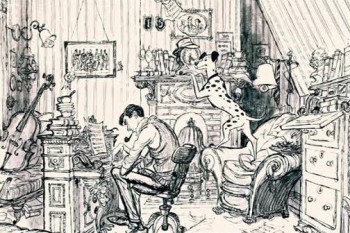 - Here is the final part of Scene 45 from 101 Dalmatians as animated by Milt Kahl. When this scene was loaned to me, it took less than a mezzo second for me to recognize it. I love it and have studied it frame-by-frame off the video (first a VHS then the DVD) many times. It’s a seminal scene for me. Just gorgeous.
- Here is the final part of Scene 45 from 101 Dalmatians as animated by Milt Kahl. When this scene was loaned to me, it took less than a mezzo second for me to recognize it. I love it and have studied it frame-by-frame off the video (first a VHS then the DVD) many times. It’s a seminal scene for me. Just gorgeous.
I’ve always loved the first fifteen to twenty minutes of Disney features (at least up
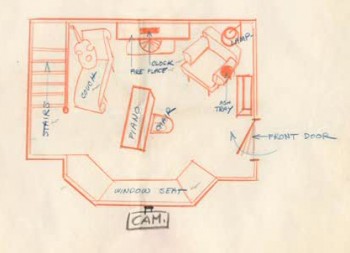 through Sword in the Stone.) Their intelligent introductions of principal characters usually comes in those first few minutes, and it’s always done with class. I think of Pinocchio, Gepetto, and Jiminy Cricket or Dumbo’s birth or Lady as a puppy or Bambi’s birth and discovering the world of the forest or Peter and Tink meeting the Darling children and “Off to Neverland.” These moments are thrilling to me, and usually the rest of the film doesn’t hold up to this.
through Sword in the Stone.) Their intelligent introductions of principal characters usually comes in those first few minutes, and it’s always done with class. I think of Pinocchio, Gepetto, and Jiminy Cricket or Dumbo’s birth or Lady as a puppy or Bambi’s birth and discovering the world of the forest or Peter and Tink meeting the Darling children and “Off to Neverland.” These moments are thrilling to me, and usually the rest of the film doesn’t hold up to this.
101 Dalmatians doesn’t fail to deliver in this respect. Exposition and introduction are done so beautifully.
The animation is, for the most part, on twos. There are a couple of ones at the very end ot the scene as Roger shakes his wrist. If you want to visit the first two parts go here for Part 1 or here for Part 2.
We start today with the last drawing from the second post.
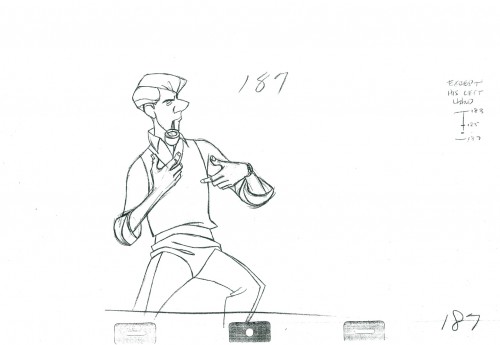 187
187
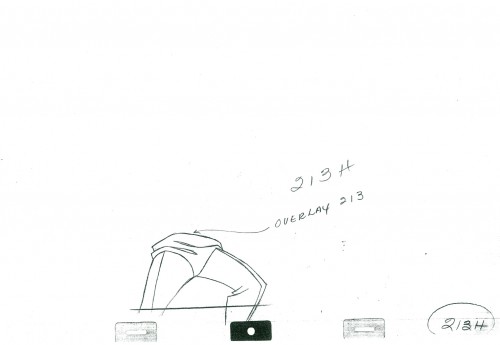 213H
213H
The legs move to their own level at this point.
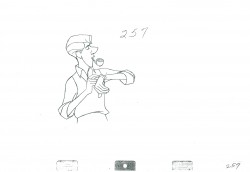
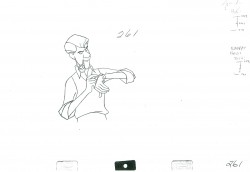
A drawing is skipped here (to be inbetweened.)
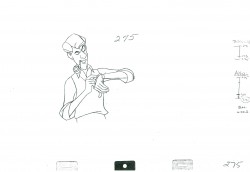
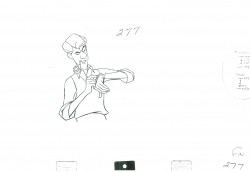
A drawing is skipped, needs inbetweening.
______________________
The following QT includes the entire sequence
which includes all drawings posted.
The registration is a bit loose. Sorry but, these are copies of
copies and there’s plenty of shrinkage.
If you click on the right side of the lower bar
you can watch it one frame at a time.
.
For more on 101 Dalmatians check out the animator drafts on Hans Perk‘s great and resourceful site, A Film LA. Hans has also posted Bill Peet‘s story treatment for the film several years ago. See it here.
For a look at the art direction of the film including some beautiful reconstructions of the BGs as well as some of the BG layouts go to Hans Bacher‘s great site One1More2Time3.
Andreas Deja has one of the more extraordinary blogs to visit. He just posted some beautiful drawings by some of the key animators on 101 Dalmatians as they set about to find the characters. See them here as well as a comparison of Milt Kahl‘s characters against Bill Peet‘s version. here
For those who own Fraser MacLean‘s excellent book, Setting the Scene, you’ll know that on pages 182-188 there’s an extensive discussion of this opening sequence from the film with plenty of beautiful images of the set.
Books &Commentary 03 Nov 2011 06:58 am
Dad’s Daughter’s book – an Overdue Review
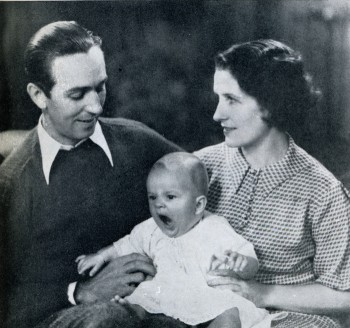 - I haven’t read the book, The Story of Walt Disney by Diane Disney Miller “as told to Pete Martin“, since it was originally published in 1957. Actually, I probably read the version that was serialized in the Saturday Evening Post in November 1956; then I most likely asked for a copy of the book for a Christmas present and read it then. After all, I was only 11.
- I haven’t read the book, The Story of Walt Disney by Diane Disney Miller “as told to Pete Martin“, since it was originally published in 1957. Actually, I probably read the version that was serialized in the Saturday Evening Post in November 1956; then I most likely asked for a copy of the book for a Christmas present and read it then. After all, I was only 11.
I remember being grabbed by the book and hooked for all time on animation. Two years later, the Bob Thomas Art of Animation would lock it up for me.
The Story of Walt Disney is an odd book to review. I wonder how much actual research went into the writing. Was it enough to have the source, Walt Disney, reveal his story verbally to Diane and Pete Miller? The voice undoubtedly comes through. The book comes off as one for youngsters; there’s an innocence in the writing that Pete Miller obviously got across. He did the writing; the book is labelled “by Diane Disney Miller as told to Pete Martin.” Martin was a writer for The Saturday Evening Post, where the book was serialized prior to its publication. Miller was also known for having collaborated with Bing Crosby on a book of memoirs before working on this Disney book.
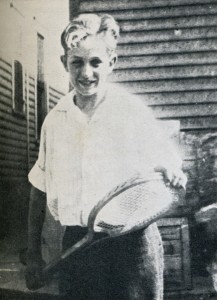 Since this book is essentially out of the mouth of Walt, we have to pay attention to some of the stories being told. What was told and what was skipped?
Since this book is essentially out of the mouth of Walt, we have to pay attention to some of the stories being told. What was told and what was skipped?
There’s quite a bit more than usual about the Red Cross service Disney did at the end of WWI.
The “Alice” series is called by the title “Alice in Cartoonland.” Unfortunately, the Disney brothers called the series the “Alice Comedies.” Even though their first short was known as “Alice’s Wonderland,” they didn’t refer to the others with any reference to Lewis Carroll’s work. That may well have been the demand of the distributor Charles Mintz even though the Disneys may have thought of the series as “Alice in Cartoonland.” Obviously, Walt referred to it as that title in telling this story.
There’s a mention of Ub Iwerks when Walt asked him to move out to LA, but there’s no mention of his name when Iwerks left Disney to open his own studio under the assistance of Pat Powers. There’s some detail in the chapter about Snow White, but barely a mention of Pinocchio or Bambi. Lots to tell about Fantasia and a bit more about Dumbo. No mention
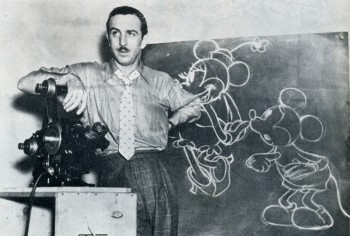 of Song of the South, Fun and Fancy Free or So Dear to My Heart, but Cinderella gets attention as do the documentary nature films. There’s an odd telling of the Disney strike in this book, and the suggestion of how the South American trip came about. In truth, the book becomes more about the juggling of money once Snow White goes into production and less about the actual films. There’s plenty of detail about going public with the stock options, and there’s a lot of detail about the government work done during WWII.
of Song of the South, Fun and Fancy Free or So Dear to My Heart, but Cinderella gets attention as do the documentary nature films. There’s an odd telling of the Disney strike in this book, and the suggestion of how the South American trip came about. In truth, the book becomes more about the juggling of money once Snow White goes into production and less about the actual films. There’s plenty of detail about going public with the stock options, and there’s a lot of detail about the government work done during WWII.
An interesting sentence comes at the beginning of the book when we read about the farm in Marcelline in hs childhood. “He can still draw a mental – or rather a sentimental – map of that whole community exactly as it was then.” This is a rare sentence by Diane commenting on her father’s recollections, and one wishes there were more like it. The last chapter of the book offers a bit more of this when Diane decides to tell a bit more about her father away from the office. What he likes to eat, how he acts, etc. There’s a lot of personality in this chapter.
One wonders how useful this book is for actual animation historians. Mike Barrier and John Canemaker have obviously read it, but do they trust the material? And why shouldn’t they, especially if there’s a second source for any of it. The story as a whole is very readable, and one rolls along easily in the telling of the tale. It’s especially entertaining. Obviously, the goal was to make the story for the largest possible audience, so details of the films were less interesting than the struggles of the imaginative entrepreneur.
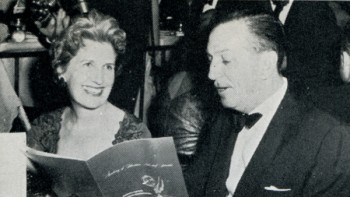 You know that “dad” enjoyed telling his daughter of all his accomplishments. So this is his version, and it’s interesting how it comes out filtered through the voices of Diane and Pete Miller. Diane’s pride in the studio is certainly as great as Walt’s.
You know that “dad” enjoyed telling his daughter of all his accomplishments. So this is his version, and it’s interesting how it comes out filtered through the voices of Diane and Pete Miller. Diane’s pride in the studio is certainly as great as Walt’s.
- “Father did the outlines of the drawings. The other two filled them in. Gradually Father gave them bigger assignments, until they were doing whole scenes themselves. Even then Father insisted upon a distinctive Disney style of drawing and photography, and he trained his two helpers to do things his way.
.
“They weren’t the only ones who have conformed to the Disney style. Almost all animated techniques since have conformed to the basic formulas that emerged from that primitive studio. Although they may vary in spirit, or another cartoon maker’s conception of what gives greater pictorial impact may differ from Father’s, they all owe a debt that goes back to the inventiveness and experimentation that went on in the back room of that converted real estate office.”
That sense of pride is understandable.
The Story of Walt Disney is actually a good read if you have a copy and haven’t seen it in years. Or you might be able to locate a copy in the library. Take the time; it moves quickly and is fun.
Animation Artifacts &John Canemaker &repeated posts 24 Oct 2011 06:51 am
Pink Elephant Recap
- Recently, I saw a small part of Aladdin on television. A large part of the Genie’s song reminded me of Pink Elephants from Dumbo. I thought, then, that I should post anew the models/sketches and drawings from that sequence. It originally was broken in two parts when it saw daylight here in 2007. I’ve combined the two posts into one.
Once again, thanks to John Canemaker, I have several photo images to display. Some frame grabs accompany the piece.
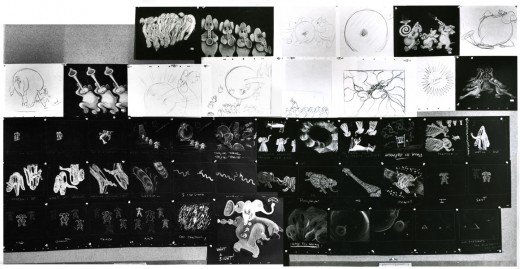
These are rather small images, so by cutting up the large boards and reassembling them I can post them at a higher resolution, making them better seen when clicking each image.
I’ve interspersed some frame grabs from the sequence to give an idea of the coloring.
The following images were in the gallery part of the dvd. These are the color versions of some of the images above.
Commentary 03 Sep 2011 06:55 am
Schmoozing
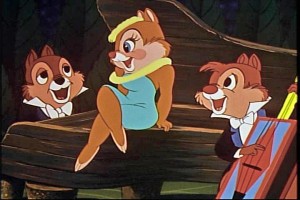 - Mike Barrier posted a letter on his site. Kevin Hogan questions Mike’s ability to enjoy an animated film now that his taste has been formed by a lot of information learned over a lifetime of study. Mr. Hogan gives as an example the Chip n’ Dale cartoon Two Chips and a Miss. He loved this short as a child and found himself not enjoying it quite as much seeing it as an adult. He suggests that Mike’s knowledge might get in the way of the “innocence” he had as a child in enjoying some of these films. It’s an honest question, and it opened into a full discussion with Thad Komorowski and Milt Gray among others discussing the theory. Mike talks about enjoying the Three Stooges in his younger days but not quite enjoying them as much in recent days. His knowledge of film and this thoughts on the filmmaking process inform his judgment (thank god).
- Mike Barrier posted a letter on his site. Kevin Hogan questions Mike’s ability to enjoy an animated film now that his taste has been formed by a lot of information learned over a lifetime of study. Mr. Hogan gives as an example the Chip n’ Dale cartoon Two Chips and a Miss. He loved this short as a child and found himself not enjoying it quite as much seeing it as an adult. He suggests that Mike’s knowledge might get in the way of the “innocence” he had as a child in enjoying some of these films. It’s an honest question, and it opened into a full discussion with Thad Komorowski and Milt Gray among others discussing the theory. Mike talks about enjoying the Three Stooges in his younger days but not quite enjoying them as much in recent days. His knowledge of film and this thoughts on the filmmaking process inform his judgment (thank god).
I probably would have gone to Alfred Hitchcock. Here’s someone who made films that can and should be appreciated on so many levels. They’re done for the public, and the manipulation Hitchcock maneuvers to create his films gets that audience by the throat, and Hitchcock enjoys doing so. Yet that same manipulation becomes obvious to the informed film student. However, for that same knowledgeable filmgoer, it doesn’t lessen the value of the film knowing how and what is coming. It makes it more fun because Hitchcock was a Master.
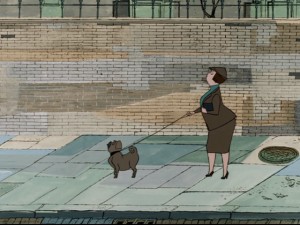 - As a 14 year old child, I was blown away by 101 Dalmatians. Those first ten minutes were heaven to me. I loved the design and the animation of Cruella de Ville, Pongo & Perdita, and even some of the pups. I was not as enthralled by the middle action-adventure section (immediately following the “Twilight Bark”). I had a lot of respect for what was being done, but I preferred the London portion of the film. I did know a lot about animation when I first saw it, but I know a lot more now. I also, now, know quite a bit about 101 Dalmatians, itself. The odd thing is that my opinion hasn’t changed a bit since that first screening. Today, I am in awe of the beautiful walk cycles Blaine Gibson animated at the beginning of the film as Pongo eyes potential mates. Throughout the film, I can see all the cuts, cel shadows, interesting effects and mistakes within them, and, yet, I still love the movie. Everything has changed within me, but nothing has changed within the movie that I first saw. It’s still excellent.
- As a 14 year old child, I was blown away by 101 Dalmatians. Those first ten minutes were heaven to me. I loved the design and the animation of Cruella de Ville, Pongo & Perdita, and even some of the pups. I was not as enthralled by the middle action-adventure section (immediately following the “Twilight Bark”). I had a lot of respect for what was being done, but I preferred the London portion of the film. I did know a lot about animation when I first saw it, but I know a lot more now. I also, now, know quite a bit about 101 Dalmatians, itself. The odd thing is that my opinion hasn’t changed a bit since that first screening. Today, I am in awe of the beautiful walk cycles Blaine Gibson animated at the beginning of the film as Pongo eyes potential mates. Throughout the film, I can see all the cuts, cel shadows, interesting effects and mistakes within them, and, yet, I still love the movie. Everything has changed within me, but nothing has changed within the movie that I first saw. It’s still excellent.
- Jeffrey Pepper’s excellent website 2719 Hyperion has featured the odd Disney short, Donald and the Wheel, in a fine analysis. The article was originally posted on the site in 2009, but this is the first time I’ve caught up with it.
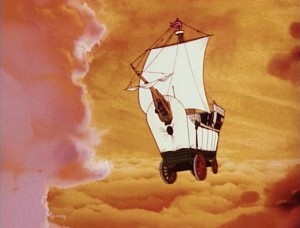 I initially saw this short when it was originally released in 1961. It played locally in New York on a bill with a non-Disney live-action feature (which I can’t remember.) I have to say that I wasn’t in tune with this short, but I enjoyed the surprise of seeing it in the theater back then.
I initially saw this short when it was originally released in 1961. It played locally in New York on a bill with a non-Disney live-action feature (which I can’t remember.) I have to say that I wasn’t in tune with this short, but I enjoyed the surprise of seeing it in the theater back then.
An even greater delight for me was seeing Symposium of Popular Song with the film, P.T. 109 in 1963. Also on that bill was the Disney animated short, The Saga of Windwagon Smith. I don’t remember that much about the feature (other than an image of Cliff Robertson as JFK), but I do remember the two shorts which I’ve seen many times. I absolutely love Windwagon Smith and have studied it backwards and forwards. I also bought a couple of drawings when I saw them available on ebay. Symposium of Popular Song took the TV creation, Ludwig Von Drake and introduced him to theaters in this Bill Justice/Xavier Attencio short that was primarily stop-motion cut out animation. What a double bill! And I’m talking about the shorts, not the feature.
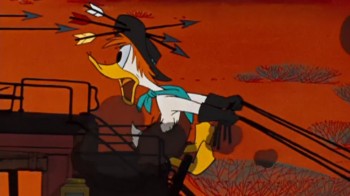 I had seen Donald in Mathmagicland many times prior to ever seeing this newer film. I can’t say I have the same love for Donald and the Wheel. I had a very hard time accepting the two narrators: the Spirits of Progress, Sr., and Progress, Jr. They’re silhouettes done using the Sodium Process invented by Ub Iwerks and used in Hitchcock’s The Birds and Disney’s Mary Poppins. The halo around the characters is all we see of them, and they’re boring, and their song was worse. (I remember spending a lot of time back then trying to figure out how they were done.) As 2719 Hyperion points out Donald and the Wheel did some experimenting with the Xerographic process preparing the way for features like 101 Dalmatians and Sword In The Stone.
I had seen Donald in Mathmagicland many times prior to ever seeing this newer film. I can’t say I have the same love for Donald and the Wheel. I had a very hard time accepting the two narrators: the Spirits of Progress, Sr., and Progress, Jr. They’re silhouettes done using the Sodium Process invented by Ub Iwerks and used in Hitchcock’s The Birds and Disney’s Mary Poppins. The halo around the characters is all we see of them, and they’re boring, and their song was worse. (I remember spending a lot of time back then trying to figure out how they were done.) As 2719 Hyperion points out Donald and the Wheel did some experimenting with the Xerographic process preparing the way for features like 101 Dalmatians and Sword In The Stone.
But I do pine for the time when a feature – not even a Disney feature – would be accompanied by two such animated shorts. Seeing a Pixar short attached to a Pixar long is not the same thing, believe me. 1963 was also a time beyond the Saturday morning kids matinees in theaters when 10 “Color Cartoons” were featured with a Francis the Talking Mule film. No, it was just part of the filmgoing process to be able to see an animated short on a big screen.
- This week I received an email from Louai Abuosba. Along with a number of others, he’s come up with a “meetup.com group aimed at providing a structure for student and professional NYC area. Animators to teach each other skills they don’t have or want to sharpen.” They met this past week in Dumbo and have plans for future meetings. If anyone is interested, you can sign up using Facebook or just go to the site and send Louai a note. (Sorry I didn’t get this out in time for the Sept. 1st meeting, their first, but I got the information too late to get it on the Splog.)
Animation &Animation Artifacts &Disney &repeated posts &Tytla 24 Aug 2011 07:09 am
Baby Mine recap
To continue with all things Tytla, here’s a representation of the “Baby Mine” sequence from Dumbo. This is one of my very favorite sequences in one of my favorite animated films. The newish Blue Ray version of this film is excellent except for one thing. The commentary on this disc pales in comparison to the 60th Anniversary DVD. The original was done solely by John Canemaker and is enormously informative. I wish John would just turn that track into a book.
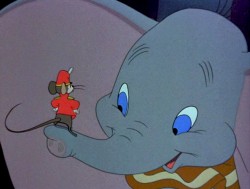 - Dumbo is certainly one of my favorite Disney features if not THE favorite. Naturally, the “Baby Mine” sequence is a highlight. The sequence is so tender and fine-tuned to appear straightforward and simple. This, of course, is the heart of excellence. It seems simple and doesn’t call attention to itself.
- Dumbo is certainly one of my favorite Disney features if not THE favorite. Naturally, the “Baby Mine” sequence is a highlight. The sequence is so tender and fine-tuned to appear straightforward and simple. This, of course, is the heart of excellence. It seems simple and doesn’t call attention to itself.
This is a storyboard composed of LO drawings from the opening of that sequence. They appear to be BG layouts with drawings of the characters cut out and pasted in place.
It’s not really a storyboard, and I’ve always wondered what purpose such boards served to the Disney machine back in the Golden Age.
Below is the board as it stands in the photograph.

_____________(Click any image to enlarge.)
Here is the same photographed board, split up so that I can post it in larger size. I’ve also interspersed frame grabs from the actual sequence for comparison.
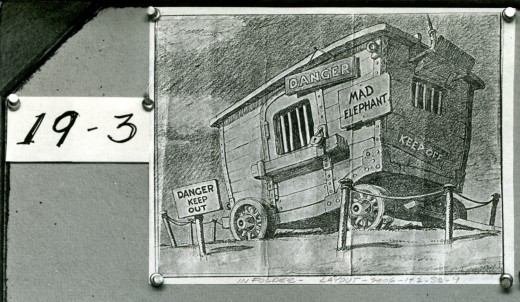
Thanks to Steve MacQuignon for locating this video.
Info from Hans Perk at A Film LA:
Directed by Bill Roberts and John/Jack Elliotte, assistant director Earl Bench, layout Al Zinnen.
Animation by Bill Tytla (Dumbo & Mrs. Jumbo’s trunk), Fred Moore (Timothy) and assorted animals by Bob Youngquist, Harvey Toombs, Ed Aardal and John Sewell.
Hans Perk has posted the drafts for Dumbo, and this has led Mark Mayerson to post the brilliant Mosaics he’s created for the film.
Animation &Animation Artifacts &Disney &repeated posts 17 Aug 2011 06:38 am
Dumbo’s Bath – recap
Continuing the celebration of Bill Tytla’s magnificent artrwork, I’m reposting this piece on Dumbo’s bath.
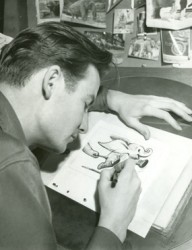 - Thanks to a loan from John Canemaker, I can continue posting some of the brilliant storyboard work of Bill Peet. The guy was a masterful artist. Every panel gives so much inspiration and information to the animators, directors and artists who’ll follow up on his work.
- Thanks to a loan from John Canemaker, I can continue posting some of the brilliant storyboard work of Bill Peet. The guy was a masterful artist. Every panel gives so much inspiration and information to the animators, directors and artists who’ll follow up on his work.
This is the sequence from Dumbo wherein baby Dumbo plays around the feet of his mother. Brilliantly animated by Bill Tytla, this sequence is one of the greatest ever animated. No rotoscoping, no MoCap. Just brilliant artists collaborating with perfect timing, perfect structure, perfect everything. Tytla said he watched his young son at home to learn how to animate Dumbo. Bill Peet told Mike Barrier that he was a big fan of circuses, so he was delighted to be working on this piece. Both used their excitement and enthusiasm to bring something brilliant to the screen, and it stands as a masterpiece of the medium.
Of this sequence and Tytla’s animation, Mike Barrier says in Hollywood Cartoons, “What might otherwise be mere cuteness acquires poignance because it is always shaded by a parent’s knowledge of pain and risk. If Dumbo “acted” more, he would almost certainly be a less successful character—’cuter,’ probably, in the cookie-cutter manner of so many other animated characters, but far more superficial.”
I had to take the one very long photstat and reconfigure it in photoshop so that you could enlarge these frames to see them well. I tried to keep the feel of these drawings pinned to that board in tact.
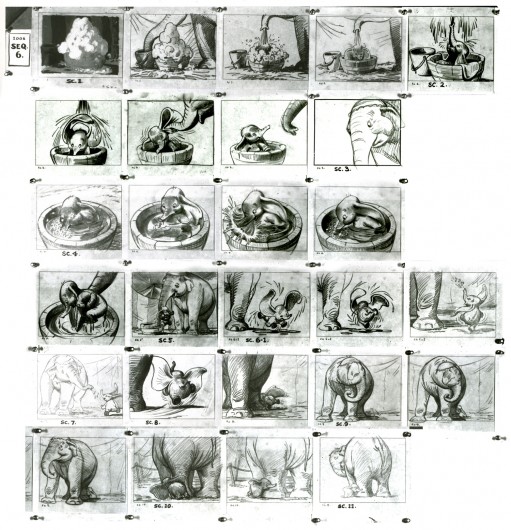
(Click any image to enlarge.)
Here are frame grabs from the very same sequence of the film showing how closely the cuts were followed. Even in stills the sequence is stunning.

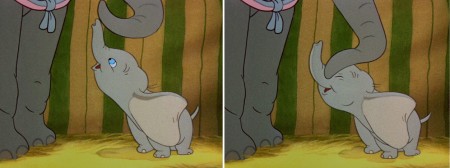
(Click any image to enlarge.)
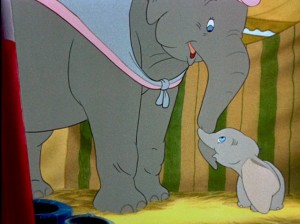 .
.This film is a gem.
The dvd also has one of my favorite commentary tracks throughout.
John Canemaker, by himself, talking about the film. It’s great!
From Hans Perk’s A Film LA:
Seq. 06.0 “Menagerie – Mrs. Jumbo Goes Berserk”
Directed by Wilfred Jackson, assistant director Jacques [Roberts?], layout Terrell Stapp.
Dumbo being washed by Mrs. Jumbo, animated by Bill Tytla, with effects by Art Palmer, Cornett Wood and Sandy Strother.
Animation &Animation Artifacts &John Canemaker 03 Aug 2011 05:36 am
Tytla Devil Recaps
Continuing with my recaps of Bill Tytla’s Disney animation, I’ve put together a couple of past posts to show you some of the beautiful drawing Tytla did on Fantasia‘s Night On Bald Mountain sequence.
- Here’s what for me was a real treat to scan and post. I had some limited access to actual drawings by Bill Tytla of the Devil from Fantasia. The drawings are mostly roughs by Tytla, and they give a good sample of what his actual work looked like.
I don’t need to write about it; let me just give you these mages.
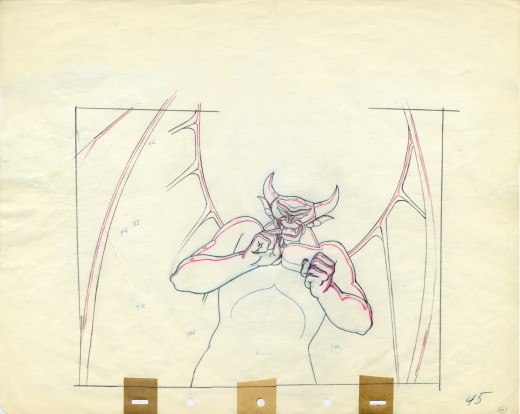
A good example of a Tytla drawing.
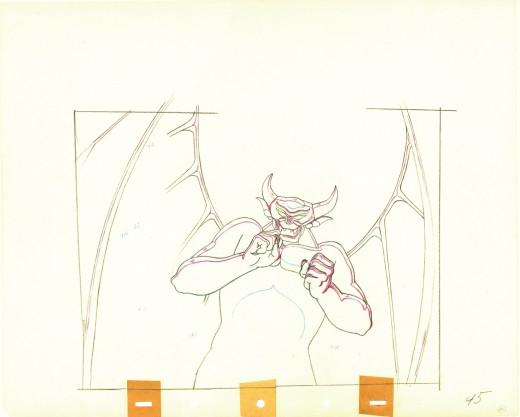
Here’s the clean up of the same drawing.
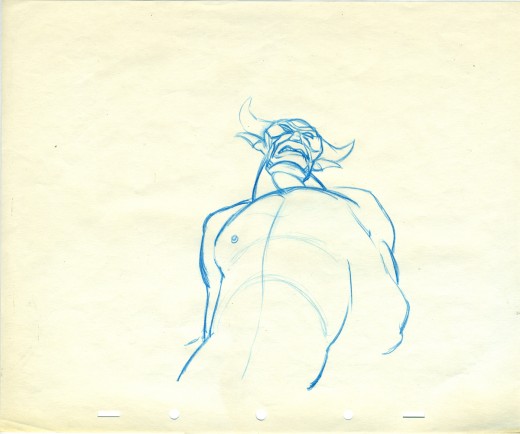
Animation roughs don’t get any more beautiful than this.
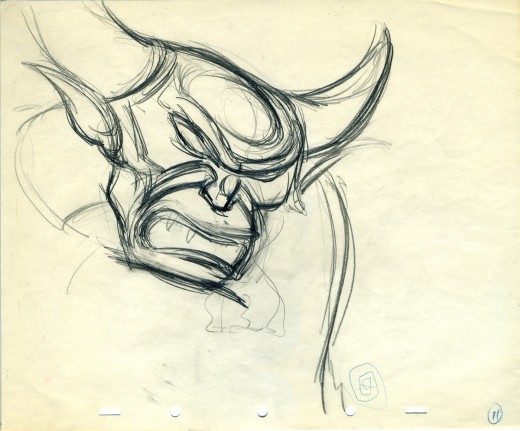
Art. What else need be said?
The individual drawings are stunning, and they’re
in service to a brilliantly acted sequence.
It will never get better.
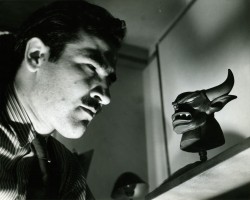 - Going under the assumption that there never are enough of Tytla’s Devils on the internet, I’ve got a few drawings to show here.
- Going under the assumption that there never are enough of Tytla’s Devils on the internet, I’ve got a few drawings to show here.
These were photographs of drawings taken (rather dark exposure that I lightened a bit) of what appears to be some cleanups. Most of them are from one scene; one drawing is from another. They’re all treasures.
How do you go from delicate Dumbo’s bath to this? That’s acting!
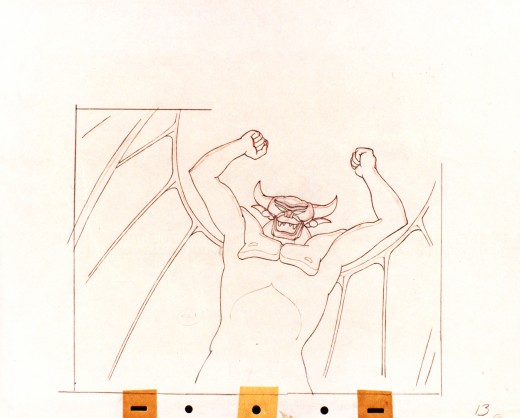
(Click any image to enlarge.)
Animation &Animation Artifacts &Disney &John Canemaker &repeated posts &Tytla 20 Jul 2011 07:31 am
Tytla’s Stromboli – the First half
As stated last week, I’m recapping some of my Tytla posts from the past. This very long scene was originally in five parts. Today and tomorrow all five parts will be posted.
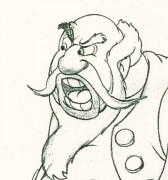 - Bill Tytla‘s work has to be studied and studied and studied for any student of animation. He was the best, and it’s pretty doubtful his work will be superceded. He brought beautiful distortion to many of the drawings he did, using it as a way to hammer home some of the emotions in the elasticity he was creating. Yet, the casual observer watching this sequence in motion doesn’t ever notice that distortion yet can feel it in the strength of the motion.
- Bill Tytla‘s work has to be studied and studied and studied for any student of animation. He was the best, and it’s pretty doubtful his work will be superceded. He brought beautiful distortion to many of the drawings he did, using it as a way to hammer home some of the emotions in the elasticity he was creating. Yet, the casual observer watching this sequence in motion doesn’t ever notice that distortion yet can feel it in the strength of the motion.
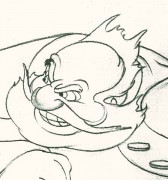
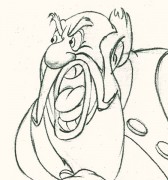
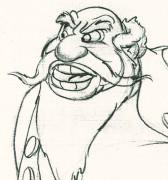
Four drawings (#1, 11, 22, & 48) that shift so enormously but call no attention to itself.
Brilliant draftsmanship and use of the forms.
Here we have the beginning: drawings 1-48. More will come in the future.
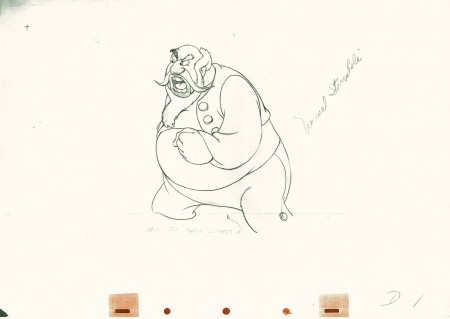 1
1(Click any image to enlarge.)
This note arrived from Borge Ring after my first post Bill Tytla’s scene featuring Stromboli’s mood swing:
- The Arch devotees of Milt Kahl have tearfull misgivings about Wladimir Tytla’s magnificent language of distortions. ‘”Yes, he IS good. But he has made SO many ugly drawings”
Musicologists will know that Beethoven abhorred the music of Johan Sebastian Bach.
yukyuk
Børge
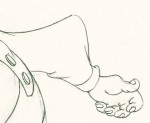
My first post spoke a bit about the distortion Tytla would use to his advantage to get an emotional gesture across. It’s part of the “animating forces instead of forms†method that Tytla used. This is found in Stromboli’s face in the first post. In this one look for this arm in drawing #50. It barely registers but gives strength to the arm move before it as his blouse follows through in extreme.
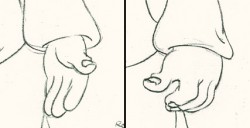 There’s also some beautiful and simple drawing throughout this piece. Stromboli is, basically, a cartoon character that caricatures reality beautifully. A predecessor to Cruella de Vil. In drawings 76 to 80 there’s a simple turn of the hand that is nicely done by some assistant. A little thing among so much bravura animation.
There’s also some beautiful and simple drawing throughout this piece. Stromboli is, basically, a cartoon character that caricatures reality beautifully. A predecessor to Cruella de Vil. In drawings 76 to 80 there’s a simple turn of the hand that is nicely done by some assistant. A little thing among so much bravura animation.
Many people don’t like the exaggerated motion of Stromboli. However, I think it’s perfectly right for the character. He’s Italian – prone to big movements. He’s a performer who, like many actors in real life, goes for the big gesture. In short his character is all there – garlic breath and all. It’s not cliched and it’s well felt and thought out. Think of the Devil in “Night on Bald Mountain” that would follow, then the simply wonderful and understated Dumbo who would follow that. Tytla was a versatile master.
Here’s part 2 of the scene:
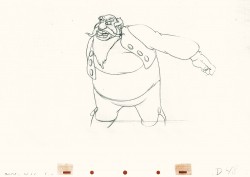 48
48 49
49(Click any image to enlarge.) The full scene with all drawings.
Click left side of the black bar to play.
Right side to watch single frame.
David Nethery had taken my drawings posted and synched them up to the sound track here.
Commentary &Disney 18 Jun 2011 07:34 am
Sight Seeing
- This past week Jonna commented on this blog: I can only imagine how it would have been to see one of the classics at a theater (I was born in the 90’s). It would have been great fun if any of you told about a premiere or screening that you’ve attended (e.g. the first time you saw Sleeping Beauty or something).
So I thought of a couple of memories I have of seeing some of the classic Disney films theatrically for the first time. So kiddies gather round Gran’pa while he tells you a story.
 The first film I’d ever seen was Bambi. I don’t remember much about it, but I’m sure that the experience permeated my brain and sent me on a direction I could never return from. This is still one of my favorite classic Disney films. I’m not big on the cutesy aspects of the movie – specifically the “twitterpated” sequence, but I am big on everything else. Back in those days, there were often Surprise guests coming to the movie theaters to promote the shows. At this one particular event, to celebrate Christmas they drew back the curtain and had a pile of large gifts all wrapped in foil-colored gift wrap. Clarabelle the clown from the Howdy Doody Show was a special guest who was going to give out gifts to the boys and girls in the audience. He went through a short routine which ended with the supposed gift-hand-out. But it didn’t happen that way. Clarabelle took out his bottle of seltzer and started spraying the audience. The blustered theater manager called for the curtain to be closed, and that was that. Even at the age of 4 or 5, I knew we was robbed. No wonder I couldn’t remember much about Bambi.
The first film I’d ever seen was Bambi. I don’t remember much about it, but I’m sure that the experience permeated my brain and sent me on a direction I could never return from. This is still one of my favorite classic Disney films. I’m not big on the cutesy aspects of the movie – specifically the “twitterpated” sequence, but I am big on everything else. Back in those days, there were often Surprise guests coming to the movie theaters to promote the shows. At this one particular event, to celebrate Christmas they drew back the curtain and had a pile of large gifts all wrapped in foil-colored gift wrap. Clarabelle the clown from the Howdy Doody Show was a special guest who was going to give out gifts to the boys and girls in the audience. He went through a short routine which ended with the supposed gift-hand-out. But it didn’t happen that way. Clarabelle took out his bottle of seltzer and started spraying the audience. The blustered theater manager called for the curtain to be closed, and that was that. Even at the age of 4 or 5, I knew we was robbed. No wonder I couldn’t remember much about Bambi.
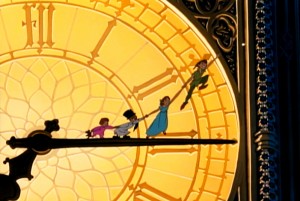 The second film I’d ever seen was Peter Pan. That would have been for the 1953 theatrical release. My father took me to one of those large movie palaces in upper Manhattan, the Loew’s 181st Street. I remember it playing with a film about a jungle cat of some kind; I’ve always remembered this as The Black Cat, but that title isn’t right. So I obviously don’t remember the title of the film, a B&W scary movie.
The second film I’d ever seen was Peter Pan. That would have been for the 1953 theatrical release. My father took me to one of those large movie palaces in upper Manhattan, the Loew’s 181st Street. I remember it playing with a film about a jungle cat of some kind; I’ve always remembered this as The Black Cat, but that title isn’t right. So I obviously don’t remember the title of the film, a B&W scary movie.
Re the animated feature, I remember most the swirls of color of Pan and gang flying; I don’t remember much else about it from that initial introduction. I was absolutely enamored with the moviegoing experience from The Black Cat to the brilliant cartoon. Remember, I was only 6 or 7 years old, at the time.
In 1955, I was in charge of about five kids (a couple of siblings and a couple of cousins) going to a local theater to see the NY premiere of Lady and the Tramp. Back then, it would cost 25 cents for a kid to get into the movies. When we’d gotten to the local movie theater for this film, they’d raised the price to 35 cents – more than our parents had allotted.
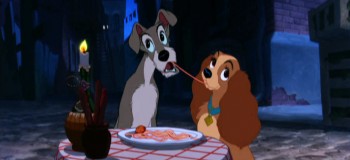 Outside the theater we were counting up our monies and trying to figure out how much we’d need to get in and buy some candy or popcorn for all of us. Within seconds my cousin announced that she’d lost her money, and it was obvious there wasn’t going to be enough for refreshments. The cousin started crying loudly, bawling until the movie theater manager came up to ask what was the problem. She spluttered out the word that she couldn’t afford any candy now that she’d lost the money to get into the movie. The manager just reached into his pocket and gave me an additional dollar. Enough money for movie and candy and more importantly it stopped my cousin’s screaming.
Outside the theater we were counting up our monies and trying to figure out how much we’d need to get in and buy some candy or popcorn for all of us. Within seconds my cousin announced that she’d lost her money, and it was obvious there wasn’t going to be enough for refreshments. The cousin started crying loudly, bawling until the movie theater manager came up to ask what was the problem. She spluttered out the word that she couldn’t afford any candy now that she’d lost the money to get into the movie. The manager just reached into his pocket and gave me an additional dollar. Enough money for movie and candy and more importantly it stopped my cousin’s screaming.
Once inside the theater I ignored them – even though the cousins were badly behaved and squirmed about through most of the show. I liked the film so much that I made the whole group sit with me to watch it a second time. That big, wide Cinemascope screen. It was heaven.
We did this often back then. I remember another time going to see Pinocchio with my younger sister, Christine. We sat through Pinocchio three times before we left the movie theater. That meant we had to sit through the second feature (usually some live action dud) twice to get to the third showing of the cartoon. My sister reminds me often enough that when she turned around she’d seen that the theater was empty except for the two of us. The usher stood in the back giving us the evil eye.
Prior to Sleeping Beauty‘s release, I’d been doing some reading. I’d received Bob Thomas’ The Art of Animation the previous Christmas, and I read it over and over at least a hundred times. I memorized every still in that book and couldn’t wait to get my eyes on Sleeping Beauty.
The film opened at Radio City Music Hall, and I was given permission to make one of my first trips downtown to see the film. An hour subway ride for a 12 year old. I went into this largest of movie theaters in the City, and I picked a great seat. The audience wasn’t overflowing; the show wasn’t sold out. But it was BIG.
The screen is enormous in that theater, and Sleeping Beauty was made to fill such a screen, especially in its Technirama debut. But somehow I came out of the theater disappointed. I don’t know what had gotten into me. I don’t remember any reason for disliking it. As a matter of fact, I absolutely love the film now. Those Eyvind Earle settings; the great animation of Maleficent; the dragon fight. There’s just a million reasons I have for loving it, but something about that first viewing left me cold. And I remember trying to analyze, at the time, what I thought was missing from the experience. I had no answer.
I’ve seen all of the pre-cgi Disney films in theaters. I also remember all the experiences of sitting through them. Dumbo and Alice In Wonderland were the only two that I saw on TV first. They were both special presentations on the Disneyland show. Eventually, I’d see them both in theaters at special screenings.
Of all of them, Dumbo still stands as my favorite though in a close tie to Snow White. There’s something they both have that goes beyond the brilliant animation and the graphics on screen. There’s an emotion there that they both have, not quite an innocence but more like a daring. Without consciously saying it, you felt the Disney people were shouting, “Look what we can do!” And they did do it. (By the time they did Fantasia, they were too conscious of what they could and had done, and they’d lost it – for me.)
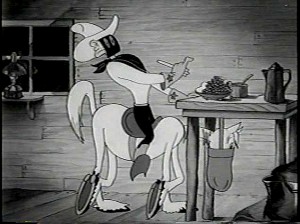 Eddie Fitzgerald is either a genius or a real-life looney toon – who I treasure. Probably, I think both; he’s at least an original. His blog is like no other in that he gives us real deep rooted comedy that makes you laugh aloud. He puts together these photo-montage storyboards creating a wacky movie that you just gotta keep reading, and when he’s on the mark, there’s nothing short of brilliance.
Eddie Fitzgerald is either a genius or a real-life looney toon – who I treasure. Probably, I think both; he’s at least an original. His blog is like no other in that he gives us real deep rooted comedy that makes you laugh aloud. He puts together these photo-montage storyboards creating a wacky movie that you just gotta keep reading, and when he’s on the mark, there’s nothing short of brilliance.
Bob Clampett did a wacky WB short called The Lone Stranger and Porky. Obviously, it was a parody of the big radio show of the time, The Lone Ranger. Well, Eddie takes off on that parody and does Clampett one better. It’s crazy and hilarious and you have to check it out (if you haven’t already.) The Lone Stranger (Parody) via photomontage.
Someone should finance this guy to make a real movie. This artwork would take cgi in a direction that hasn’t been considered before. Maybe then they’d have the first REAL animated cgi film instead of all these cutesy viewmaster things we get.
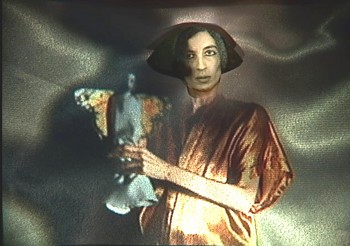 Last week I started a new series that I hope will go on forever. I’ve been interviewing Independent animators, the ones who are trying to make artful animation on their own. They don’t have the dollars that a Dreamworks would, but they’re using all of their resources to make movies that have something to say.
Last week I started a new series that I hope will go on forever. I’ve been interviewing Independent animators, the ones who are trying to make artful animation on their own. They don’t have the dollars that a Dreamworks would, but they’re using all of their resources to make movies that have something to say.
The first post was an interview with George Griffin, who has been something of an inspiration to me. Upcoming this Tuesday will be an in depth look at the amazing career of Kathy Rose. She takes animation, mixes it with dance and Performance Art and comes out with amazingly original work. I’m having a good time putting these pieces together, and there are so many who deserve the attention.
- I have one last bit of self-aggrandizement to post. THis coming Wednesday, June 22nd, HBO will premiere the latest Special we’ve done for them. (Notice how I date myself by calling it a “Special”. That’s what they were called when I was younger. These days I only know the industry word for them, “one offs”. I don’t like to think of my show as a “one off”; it’s a Special.)
The show is about half animated; the other half consists of kids saying the wackiest things. It’s fun. So there you go.


